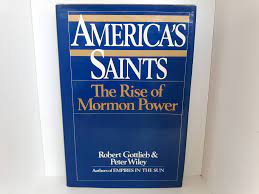Articles/Essays – Volume 18, No. 4
The Secular Side of the Saints | Robert Gottlieb and Peter Wiley, America’s Saints: The Rise of Mormon Power
It wasn’t written primarily for a Mormon audience. And it wasn’t expected to sell well in Salt Lake City. But Bob Gottlieb and Peter Wiley, both outsiders to the LDS Church and to Utah, have written a book of profound interest to Mormon readers. Over 15,000 copies of America’s Saints: The Rise of Mormon Power sold within six months of the book’s re lease in the fall of 1984. It’s selling in Salt Lake City like nowhere else. All this, despite a concerted effort by Church spokesmen to label the volume as mean spirited muckraking.
What lies behind the success of America’s Saints? I believe it is a combination of two factors: years of bottled-up curiosity among Mormons about how the Church bureaucracy works, and a creditable if imperfect attempt to explain it. LDS leaders do an excellent job describing the purposes of Church programs and motivating members to make them work. And achievements are frequently cited with satisfaction. But what member doesn’t wonder how “Correlation” works, who screens les son manuals, what criteria are used, and why seemingly good ideas are mysteriously shelved? Who isn’t curious about the dis position of their tithes and offerings—not out of suspicion, but from a natural desire to know what one’s generosity has helped make possible? Members seldom voice questions such as these, but Gottlieb and Wiley had the temerity to ask. They asked Church spokesmen, Church leaders and ordinary members. They also scoured public records, read the Doctrine and Covenants, and consulted scholarly sources both inside and outside the faith. It took them five years, but they came up with more than they, or any one else, thought they would find.
What are the unique contributions of the book? The historical material presented in America’s Saints, at least that pertaining to the pre-1970s, is hardly new. Serious students of the culture have seen most of the earlier information, for instance, in the pages of DIALOGUE. But the authors’ re view of historical events has provided a useful context for examining contemporary issues, and they have pressed their quest for information right up to the present.
If there is one place the “new Mormon history” has fallen short, it is in treating recent events. This is a traditional failing of professional historians, due to lack of sources and the risk of drawing premature conclusions; but it is accentuated among LDS historians because of added sensitivities about criticizing living leaders. Gottlieb and Wiley are neither historians nor Latter-day Saints, however, so they have pushed ahead where others have chosen not to explore. Journalists, after all, are disposed to deal with the present (and recent past) in a way that historians are not. Thus, the reader of America’s Saints is treated to rare recent information about the operation of the Church in Central and South America, contemporary financial practices and problems, and efforts by the Special Affairs Committee to influence local, state, and federal policies. The authors also examine organizational stresses brought about by the recent emergence of a pluralistic global membership governed by a rather monolithic, predominantly American, middle class theocracy.
One must credit this book with being balanced. The authors interviewed every one available—but they were limited by restrictions many Church leaders and spokesmen placed upon themselves, or had placed upon them by others. Since a fair number of people spoke off the record, some of the insights and information cannot be traced to specific origins. A gossipy air sometimes surfaces, although the blame cannot be placed wholly at the feet of the authors. They worked with what they were able to obtain. My point is that balance is especially difficult when sources are in complete. I am aware, for instance, of several enticing but unsubstantiated stories that the authors chose to leave out, simply because they would have raised difficult questions without providing sufficient ev dence for a fair and reasonable analysis. I do wish, however, that they and their publisher had provided standard footnotes and a complete bibliography, rather than the annoyingly general list of “sources” associated with each chapter.
The most vocal critics of America’s Saints have assailed the book for treating the LDS Church as though it were a secular institution—completely ignoring, they say, its spiritual dimensions. Yet the authors did not set out to explore Mormon theology or the character of Mormon community life (for which they gained great respect). They sought instead to explain the rise of Church involvement in the larger society, from the politics of opposing the Equal Rights Amendment to the intricacies of financing a global religious organization. In my view, the Church cannot claim immunity from secular criticism when it acts in the secular sphere. In the long run, efforts to secure such immunity can only be self-destructive. Without the honest perceptions of outsiders, we will not be stimulated to ask the difficult questions that can renew our courage to examine discrepancies that inevitably crop up between our spiritual values and our organizational practices.
America’s Saints has become a best selling book among the Mormons precisely because we need the kind of frank examination that Gottlieb and Wiley have provided. One hopes we have retained the capacity to learn from those with whom we share less than complete accord.
America’s Saints: The Rise of Mormon Power by Robert Gottlieb and Peter Wiley (New York: G. P. Putnam’s Sons, 1984), 278 pp., sources, index.


 Back to full Issue
Back to full Issue

